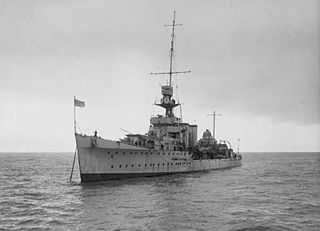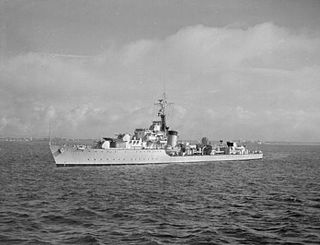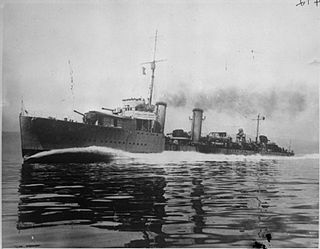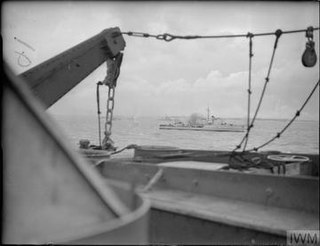
The first HMS Montrose was one of eight Admiralty-type destroyer leaders, sometimes known as the Scott class. They were named after figures from Scottish history; Montrose was named for the Graham Dukes of Montrose. She was built during the First World War, but was completed too late for service then. However, she had a long career in the inter-war years and saw extensive service during the Second World War.

HMS Jaguar was a J-class destroyer of the Royal Navy. Commissioned in September 1939, she was present at the Dunkirk evacuation the following year, during which Jaguar was damaged by dive bombers. She later served in the Mediterranean and was involved in several actions there. She was torpedoed off the coast of Egypt on 26 March 1942 and sunk.

HMS Jackal was a J-class destroyer of the Royal Navy. Completed in 1939, Jackal served in the Norwegian campaign and the Dunkirk evacuation before being deployed to the Mediterranean in 1941. Jackal took part in the Battle of Crete, and was scuttled after being heavily damaged by German bombers on 12 May 1942.

HMS Termagant was a T-class destroyer of the Royal Navy that saw service during the Second World War. She was built by William Denny and Brothers, of Dumbarton and launched on 22 March 1943. She was scrapped in 1965.

HMS Calcutta was a C-class light cruiser of the Royal Navy, named after the Indian city of Calcutta. She was part of the Carlisle group of the C class of cruisers. She was laid down by Vickers Limited at Barrow-in-Furness in 1917 and launched on 9 July 1918. Calcutta was commissioned too late to see action in the First World War and was converted to an anti-aircraft cruiser in 1939. Calcutta served during the Norwegian Campaign and the evacuation from Dunkirk in 1940. She was used to escort allied convoys across the Mediterranean and was sunk on 1 June 1941 by Luftwaffe aircraft off Alexandria, Egypt.

HMS Beaufort was a Hunt-class destroyer of the Royal Navy. She was laid down on 17 July 1940 at Cammell Laird, Birkenhead. She was launched on 9 June 1941 and commissioned on 3 November 1941. During the Second World War the ship served in the Mediterranean Sea, escorting convoys and covering landings. She was transferred to the Royal Norwegian Navy in 1952 and scrapped in 1965.
HMS Marigold was a Flower-class corvette of the Royal Navy. She was launched on 4 September 1940 and was sunk by an Italian air-dropped torpedo on 9 December 1942.

HMS Wrestler (D35) was a V and W-class destroyer built by the Royal Navy during the First World War and active from 1939 to 1944 during the Second World War. She was the first Royal Navy ship to bear that name, and the only one to do so to date.

HMS Westcott (D47) was a Royal Navy Admiralty W-class destroyer that served in the Second World War. In the Second World War Westcott served in an anti-submarine role and escorted numerous Atlantic and Malta convoys.

HMS Shikari (D85) was an Admiralty S-class destroyer of the Royal Navy. She was built by William Doxford & Sons, Sunderland and launched on 14 July 1919. She was one of the destroyers that took part in the Invergordon Mutiny. In 1933, she was briefly commanded by Frederic John Walker, who was to rise to fame as the foremost Allied submarine hunter of World War II.

HMS Bideford was a Royal Navy Shoreham-class sloop. She was named after the town of Bideford in Devon and was launched on 1 April 1931.

HMS Zephyr was a Z-class destroyer. She was launched on 13 July 1942 at Vickers-Armstrongs' High Walker shipyard and commissioned on 6 September 1944. She was 'adopted' by the civil community of Doncaster, replacing the destroyer HMS Lightning, which had originally been adopted during Warship Week in 1942.

HMS Brocklesby was a Type I Hunt-class destroyer of the Royal Navy. She served during the Second World War, spending much of the time in the English Channel and Mediterranean, taking part in the Dieppe Raid in 1942, and the Allied landings in Sicily and at Salerno in 1943. After the war, she was used as a sonar trials ship until 1963, and was sold for scrap in 1968.

HMS Mackay was an Admiralty type, sometimes known as the Scott class, flotilla leader of the British Royal Navy. Mackay was built by Cammell Laird during the First World War, but was completed too late for service then, commissioning in 1919.
HMS Talybont was a Type III Hunt-class escort destroyer who served in the Royal Navy. She was launched in February 1943 and completed in May that year, serving for the rest of the Second World War. She took part in the Normandy Landings in June 1944, supporting the landings at Omaha Beach and the Pointe du Hoc. Post war she served in the Mediterranean before being reduced to reserve at the end of 1947. She was sold for scrap in 1961, with disposal completed by 1962.

HMS Airedale was a Hunt-class destroyer built for use by the British Royal Navy during the Second World War. She entered service in early 1942 as a convoy escort, being assigned to the Mediterranean Fleet in May. Airedale was sunk while escorting a convoy from Alexandria to Malta on 15 June 1942 by Sturzkampfgeschwader 3.

HMS Cottesmore was a Hunt-class destroyer of the British Royal Navy. The ship was built by the Scottish shipbuilder Yarrow at their Scotstoun, Glasgow shipyard in 1939–1940, being launched on 5 September 1940 and commissioning on 29 December that year.

HMS Sturdy was an S-class destroyer, which served with the Royal Navy. Launched in 1919, the destroyer visited the Free City of Danzig the following year but then spent most of the next decade in the Reserve Fleet. After a brief period of service in Ireland in 1931, Sturdy was divested of armament in 1934 and equipped with a single davit to rescue ditched aircraft, and acted as plane guard to the aircraft carrier Courageous. The ship subsequently took part in the 1935 Naval Review. Re-armed as a minelayer, the destroyer was recommissioned the following year and reactivated at the start of the Second World War. Sturdy was then employed escorting convoys in the Atlantic Ocean, but ran aground off the coast off the Inner Hebrides island at Tiree in 1940. The vessel was split in two by the waves. The crew evacuated, apart from three sailors who died, and the destroyer was lost.

HMS Stork was an R-class destroyer that served in the Royal Navy during the First World War. The R-class were an improvement on the previous M-class with geared steam turbines to improve efficiency. Launched by Hawthorn Leslie at Hebburn in 1917, Stork joined the Harwich Force. The destroyer saw service escorting convoys in the English Channel and encountered both German submarines and torpedo boats, but did not record any hits on the enemy. The vessel also supported attacks on German forces on the coast of Western Europe by Coastal Motor Boats, flying boats and monitors, including the Zeebrugge Raid of 1918.

HMS Sardonyx was an Admiralty S-class destroyer that served with the Royal Navy in the Second World War. The S class were a development of the R class created during the First World War as a cheaper alternative to the V and W class. Launched in 1919 soon after the armistice, the ship was commissioned into the Reserve Fleet. Later that year, the destroyer was sent to Latvia, arriving just after the cessation of that country's war of independence. The ship took part in radar trials in 1939, and was upgraded shortly after the start of the Second World War with greater anti-aircraft and anti-submarine capabilities. The destroyer then served as an escort, usually for convoys of merchant ships. The ship was part of the 5th Escort Group which destroyed the German submarines U-99 and U-100, although Sardonyx did not claim any hits. The destroyer was also involved in escorting the landing parties for the Normandy landings in 1944. Soon afterwards, the ship was allocated to training. Sardonyx was retired and sold to be broken up in 1945.


















